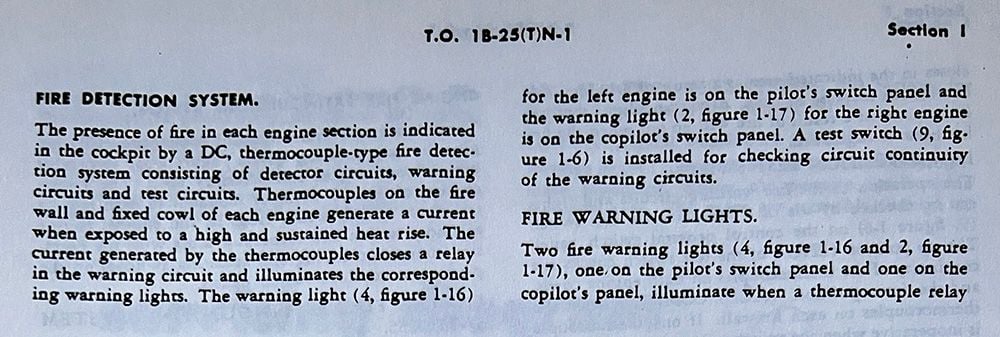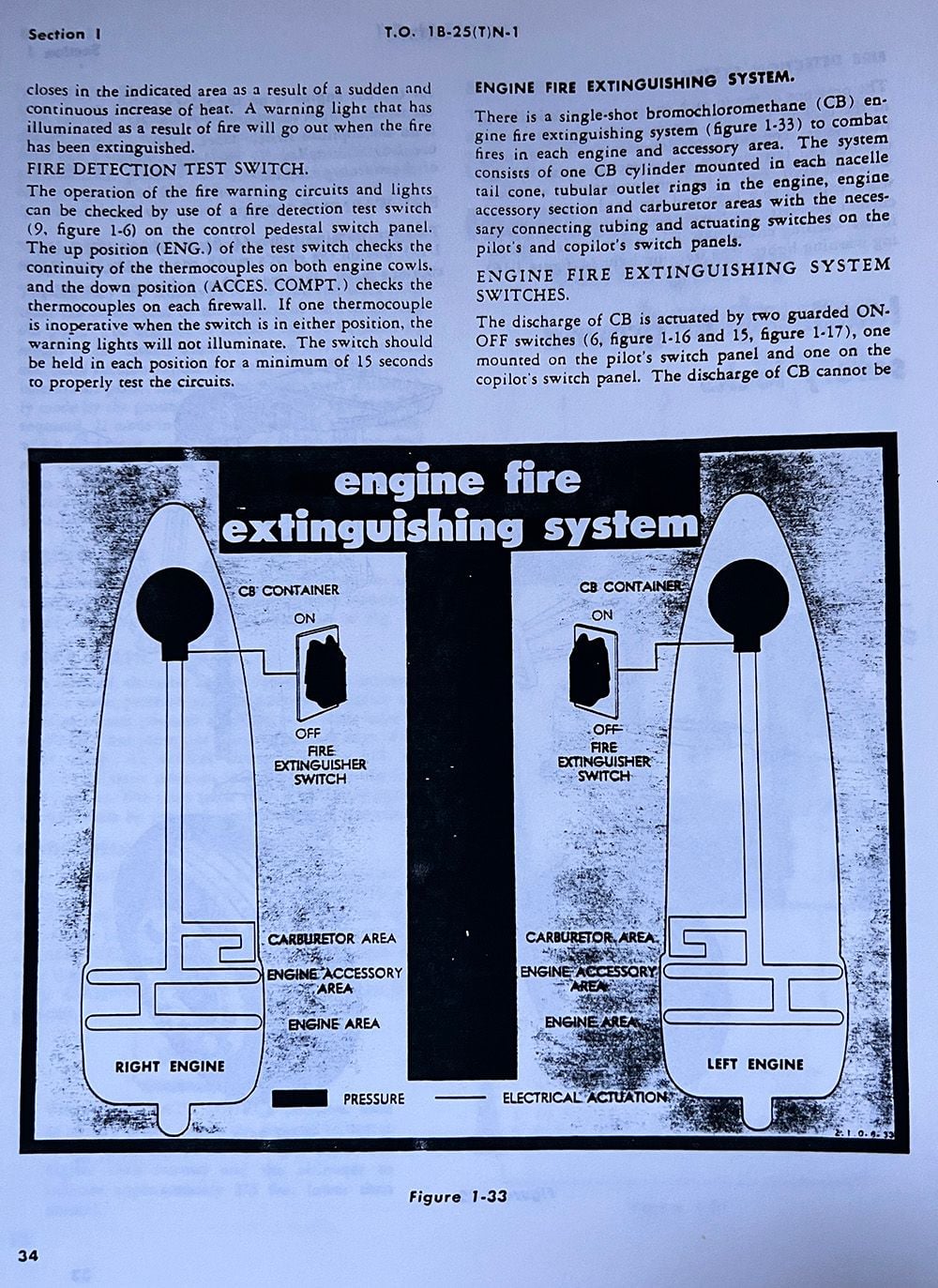Question about the B-17
Thread Starter
Join Date: Jun 2022
Location: Seattle
Posts: 100
Likes: 0
Received 0 Likes
on
0 Posts
Question about the B-17
Hi all,
Watching this training video for the B-17;
https://m.youtube.com/watch?v=ZNv0mORbwNQ
it appears that the fire warning detection system was the crew’s eyes and nose.
So what was the first aircraft to introduce aural/visual fire warnings?
Thanks,
BD
Watching this training video for the B-17;
https://m.youtube.com/watch?v=ZNv0mORbwNQ
it appears that the fire warning detection system was the crew’s eyes and nose.
So what was the first aircraft to introduce aural/visual fire warnings?
Thanks,
BD
Thread Starter
Join Date: Jun 2022
Location: Seattle
Posts: 100
Likes: 0
Received 0 Likes
on
0 Posts
The B-29 used crew scanning. Designed and built early 1940s.
And the Boeing 727 has a CBT on YouTube describing the fire warning system with lights and alarms. First flew in 1963, designed during the late 1950s - early 1960s. So there’s a
So there’s about a 15-20 year window in there.
And the Boeing 727 has a CBT on YouTube describing the fire warning system with lights and alarms. First flew in 1963, designed during the late 1950s - early 1960s. So there’s a
So there’s about a 15-20 year window in there.
Thread Starter
Join Date: Jun 2022
Location: Seattle
Posts: 100
Likes: 0
Received 0 Likes
on
0 Posts
The P-80 had a fire warning light but no aural alarm and… no extinguishing system at all! First flew 1944.
Boeing 707 FCOM says it has a light and a fire bell. First flew 1954-57 depending on how you look at it.
I’m thinking the introduction of jet engines led the way as a fire could begin well before any visual sign was available.
Boeing 707 FCOM says it has a light and a fire bell. First flew 1954-57 depending on how you look at it.
I’m thinking the introduction of jet engines led the way as a fire could begin well before any visual sign was available.
B-25 I worked on certainly had fire warning loops (multiple thermocouples) installed, but that could have been done as part of the post WWII modification to TB-25N configuration.
The Varsity first flew in 1949 and had a fire warning system based upon flame switches. I suspect the Valletta which had a number of common features and first flew in 1947 may have had a similar system.
YS
YS
Quoted for link
In the configuration that I'm familiar with, the TB-25N has an aural alert in the form of a loud bell and a visual alert in the form of a red warning light. Fire extinguishing bottles are also fitted to both engine nacelles.
The B-29 used crew scanning. Designed and built early 1940s.
I stayed on board for the engine start sequence - even more fascinating with those 4 huge Wright Cyclones thundering away!
As for civil types, while there was a flight engineer on board, you had one crewmember who was primarily concerned with the engines' health (I'm thinking DC-6/7 or Constellations) and who had a view of these engines. It would have been the types without a flight engineer on which the need for a fire warning system became more apparent. I suspect that you'll need to go through a lot of manuals to figure out which types used fire warning systems, and you most likely will not be able to point to a specific type on which this practice started.
Blue - oil, White - coolant, Black - fuel.
Not sure where that leaves white on an air-cooled radial...
White smoke on an aircraft (piston) engine usually indicates excess oil being burned off in the combustion chamber. That's why you get the large clouds of white smoke on startup (for most radial engines).


"As for civil types, while there was a flight engineer on board, you had one crewmember who was primarily concerned with the engines' health"
Busiest man on board a Constellation or a DC-7 I understand - never took his eyes off the panel in front of him
Busiest man on board a Constellation or a DC-7 I understand - never took his eyes off the panel in front of him
Thread Starter
Join Date: Jun 2022
Location: Seattle
Posts: 100
Likes: 0
Received 0 Likes
on
0 Posts
Here is the B-29 in all it’s glory:
The B-36 clip was similar to the B-17 - visually recognising fire.
I am thinking that large radials/pistons = visible smoke fire but early turbojets would not show fire escaping the combustion chamber so easily so hence the development of fire warning systems.
Does anyone have any information about the Comet for example? Wing embedded jet engines not visible from the flight deck and that flew first in 1949 so developed pre 1949
The B-36 clip was similar to the B-17 - visually recognising fire.
I am thinking that large radials/pistons = visible smoke fire but early turbojets would not show fire escaping the combustion chamber so easily so hence the development of fire warning systems.
Does anyone have any information about the Comet for example? Wing embedded jet engines not visible from the flight deck and that flew first in 1949 so developed pre 1949
The Graviner Company in Britain certainly had proper fire suppression systems available before WW2 as can be seen from this 1939 Advert below .
For Jet Aircraft engine bays Graviner developed the Graviner 'Firewire' system which was a continuous very small dia 'pipe' (for lack of a better word) which was routed around the engine bays and this detected fires/high temperatures to give audible/visual warning to the crew,this 'Firewire' system was certainly in use by the 1950's but I do not know to which aircraft type it was first fitted as standard equipment.

For Jet Aircraft engine bays Graviner developed the Graviner 'Firewire' system which was a continuous very small dia 'pipe' (for lack of a better word) which was routed around the engine bays and this detected fires/high temperatures to give audible/visual warning to the crew,this 'Firewire' system was certainly in use by the 1950's but I do not know to which aircraft type it was first fitted as standard equipment.

Thread Starter
Join Date: Jun 2022
Location: Seattle
Posts: 100
Likes: 0
Received 0 Likes
on
0 Posts
That is amazing! I am drilling down to fire alerts via aural alerts specifically so this has that but as you say; which and when it was put in a cockpit is another question.
Thanks!
Thanks!
And as for the fire detection and extinguishing system, this is from the TB-25N Flight Handbook dated 15 February 1956:


Correction on my earlier post: the fire detection system only illuminates one (or both) of the fire warning lights, there is no aural warning. I was confused and mixed it up with the evacuation alarm.


Correction on my earlier post: the fire detection system only illuminates one (or both) of the fire warning lights, there is no aural warning. I was confused and mixed it up with the evacuation alarm.
It may be worth noting that - in addition to the potential lack of visible indication of fire in a jet engine, on many swept wing jet aircraft, it's difficult - if not impossible - to actually see the engines from the flight deck.
Seeing the 747 outboard engines is difficult - inboards forget it...
Seeing the 747 outboard engines is difficult - inboards forget it...




